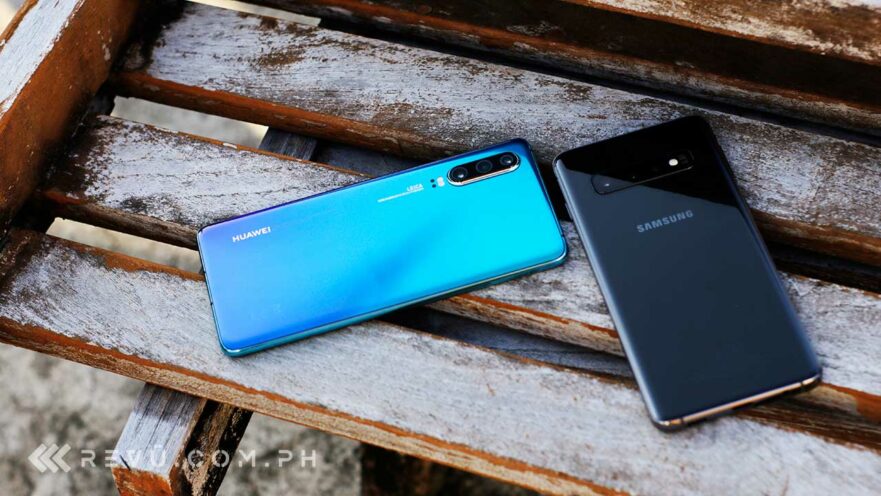The Huawei P30 and Samsung Galaxy S10 represent the best balance between affordability and attractions in a flagship effort from two of the world’s top smartphone vendors.
In the Galaxy S10, Samsung has a mainstream flagship that shares most of the same hardware as the Galaxy S10 Plus. The same can be said about the P30, which only lacks a few features from the P30 Pro. However, the Huawei phone, which is currently priced at P36,990 (roughly $710) in the Philippines, is significantly cheaper than the P49,990 ($959) Samsung flagship.
The Huawei P30 launched a month after the release of the Samsung Galaxy S10 at local retail stores. Is the latter still the gold standard in the segment, or is the P30 now a more desirable package? We decided to pit these phones against each other to see which one is really the better buy. Here’s how it went.
Design and build
Both the Huawei P30 and Samsung Galaxy S10 primarily comprise of metal sandwiched between two glass panels, although they feel quite different in the hand and look nothing alike. Huawei’s design language is more practical and comfortable to use on a daily driver. Samsung, on the other hand, prioritizes form over function, opting for a curved display on the front that is symmetrical with the glass at the rear.
But while having two curved edges on both front and back does make for prettier pictures of the device, it also makes the Galaxy S10 much more awkward to hold and operate when watching a full-screen video or playing a game in landscape mode. And that’s despite the fact that this Galaxy is roughly the same size and weight as the Huawei P30.
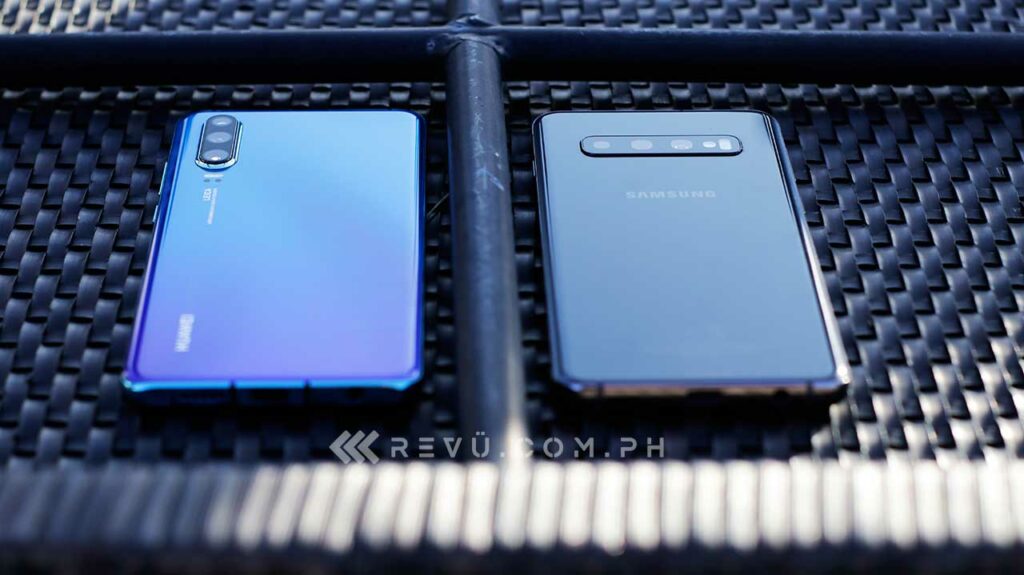
Without a rubber case to add some grip, the Samsung Galaxy S10 feels slippery, so never use it without a case
Without a rubber case to add some grip, the S10 definitely feels fragile and slippery, to the point that resting it on a table or any elevated flat surface is courting danger and a trip to the repair center.
We don’t have the same problem with the P30, even though it also has smooth glass on both sides. We’ve been using our review unit for the past two weeks, and while it isn’t rugged or rated for use in the pool, we haven’t felt the need to use the silicone case that Huawei has included in the box.
SEE ALSO: 0% interest installment plans for Huawei P30, P30 Pro, P30 Lite
Color is now as much of a feature as any spec, especially in the high-end segment where manufacturers have reserved their best and boldest for top competition. The Huawei P30 doesn’t have plenty of options to choose from, but the ones that are available are far more interesting than the black and white colors Samsung offers for the S10.
Notably, the Breathing Crystal version of the P30, which transitions from white to pale blue to pink, depending on the light and angle, is not only one of a kind, but also downright gorgeous. The blue-to-turquoise gradient of our Aurora unit looks nice, too.
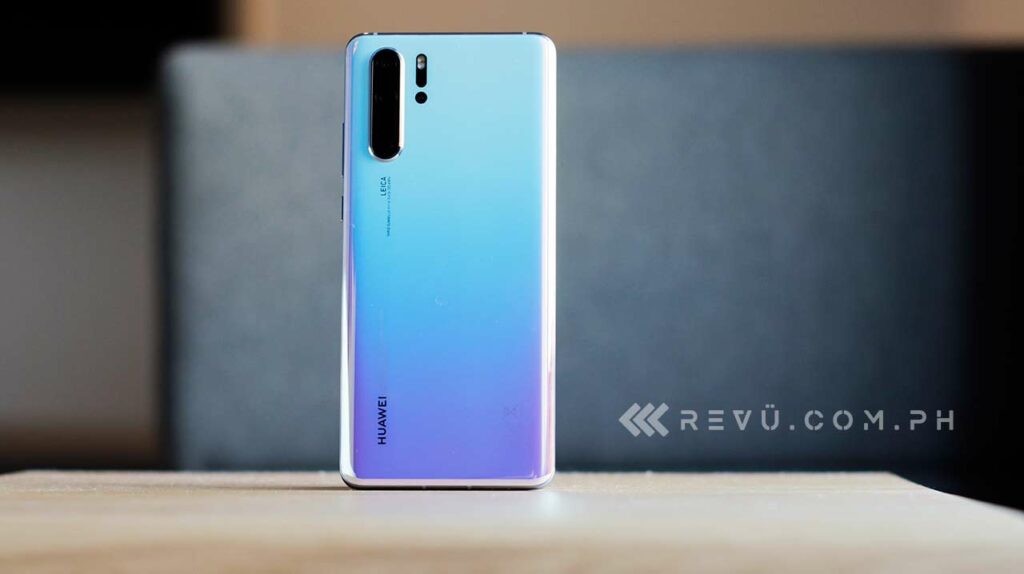
Our Huawei P30 Pro review unit. This is just to give you an idea how Breathing Crystal looks
Both the Huawei P30 and Samsung Galaxy S10 feature fingerprint scanners built into their displays, as opposed to having them on the bottom bezel or at the rear. We found them to be pretty fast and fairly accurate most of the time. The in-screen biometrics has been our default option for unlocking the phones throughout the day, and so far, it has worked well enough that we rarely use the camera-based face-unlock feature of the devices.
Button placement on the Galaxy S10 is a little awkward, as the volume rocker and dedicated button for Samsung’s Bixby digital assistant sit on the left edge, while the power key is placed on the right. The power and Bixby buttons are about the same size and shape, and there’s nothing to really distinguish them outside of their locations, which means you’re likely to press one or the other by accident until muscle memory eventually kicks in. On the P30, all buttons are on the right-hand side for ease of use.
Screen
The Huawei P30 and Samsung Galaxy S10 have 6.1-inch OLED displays with excellent color reproduction, outstanding contrast, and deep black levels. They also allow for great outdoor visibility and viewing angles in direct sunlight. Both panels support HDR10 for improved detail in highlights and shadows when viewing HDR content, and they have always-on functionality to persistently display the date, time, battery percentage, and more.
Samsung, however, pulls ahead in terms of picture output with a sharper 3,040 x 1,440 resolution compared to Huawei’s 2,340 x 1,080. On paper, we know that disparity might seem like a huge gap, but it is not really — not when you’re looking at the two handsets side by side at a reasonable distance. Samsung knows this, which is probably why the S10’s default resolution is set to 1080p instead of 1440p. Opting for a sharper screen on any device will draw more power and thus impacts battery life.
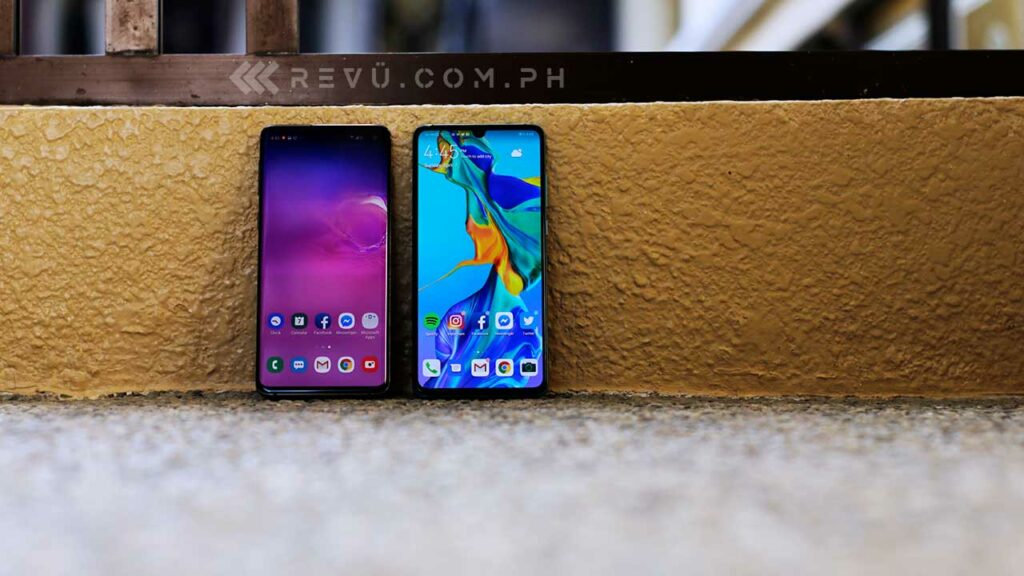
On paper, Samsung (left) pulls ahead in terms of picture output with a sharper 3,040 x 1,440 resolution compared to Huawei’s 2,340 x 1,080
The P30’s 6.1-incher produces decent clarity and can provide a pleasing viewing experience in most situations, whether you’re browsing the web through your social feeds, watching a video, or playing a graphically intensive game. The resulting image from the panel is plenty good, just not as technically good as it gets in the category.
Both screens are surrounded by narrow bezels on the top, right, and left sides, with comparatively larger chin bezels. The main difference between the two lies in the way their front-facing cameras are set up. The Huawei P30 has a small dewdrop-style notch at the top to house the selfie camera, whereas the Samsung handset gets a punch-hole cutout in the upper-right corner of the screen.
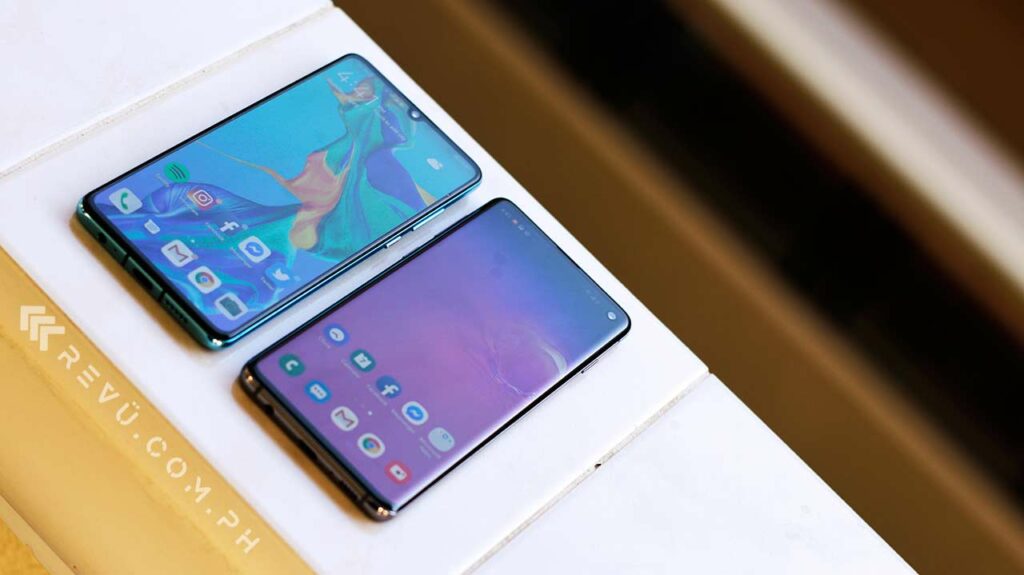
The Huawei P30 has a small dewdrop-style notch at the top to house the selfie camera, whereas the Samsung Galaxy S10 gets a punch-hole notch in the upper-right corner of the screen
Hiding the notch on the P30 is possible via software and will draw a black border in the display around the notch. Adding a black bar to the top of the S10’s screen so the front camera won’t be visible is also an option, but you’ll end up with an obnoxiously thick border that ruins the edge-to-edge design.
Cameras
If you’re looking at the Huawei P30 or Samsung Galaxy S10, it’s probably because you want a phone that excels in photography. You’d be right: The P30 and S10 boast top-notch triple-lens cameras that are more than enough to rival the best of Apple. Photography is a big selling point for both handsets, and it’s what Huawei and Samsung talked about the most at their respective launch events.
The primary camera on the P30 is 40 megapixels and features Huawei’s new SuperSpectrum sensor behind f/1.8 glass. The sensor, found in the P30 Pro also, swaps out green pixels for yellow, which allows it to capture more light and produce brighter, more color-rich shots in poor lighting.
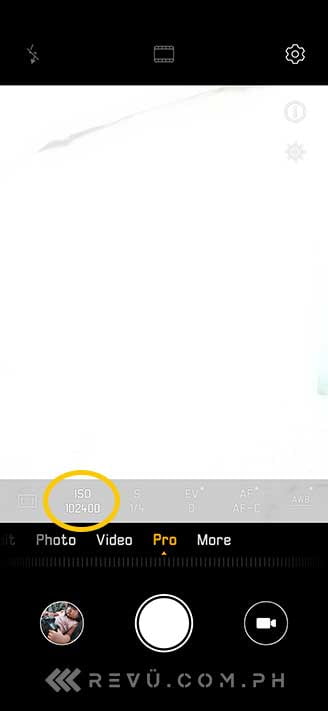
Huawei P30’s maximum ISO
But it gets better because the P30 has a sensitivity that goes up to 102,400, same as the P20 Pro’s. For general use, we found it to be just as good as the main camera on the P30 Pro, the highest-rated smartphone camera on image-quality rating site DxOMark right now. We recommend that you switch to Night mode in the camera app before taking a photo, for more brightness and dynamic range.
Screen-recorded video of the Huawei P30 while we were taking a photo of a toy placed in a box — and in a dark room at that

Huawei P30 vs Galaxy S10: Pictures captured in extreme darkness
Additionally, the Huawei P30 packs a 16-megapixel ultra-wide-angle camera and an 8-megapixel zoom shooter. The latter makes for snappier auto-focus and is capable of 30x hybrid-zoom facility, allowing you to get close to distant objects. It should prove useful in sporting events and concerts in particular, where getting close to the action is not only sometimes impossible but also undesirable (consider a professional basketball game).
The tack-sharp 32-megapixel camera in the notch of the P30 rounds out one of the best and most versatile setups on the market today. Selfies no longer look soft and lacking in fine detail like they did on previous P series models. There’s Portrait mode to add some background blur, even out your skin tone, and make your face look thinner in pictures and give it a subtle glow.
Meanwhile, the Samsung Galaxy S10’s headline attraction is its 12-megapixel camera with a variable aperture of f/1.5 or f/2.4 for improved photos in bad lighting. The two other cameras at the back are 16 and 12 megapixels, the latter being a telephoto option with 2x optical zoom or 10x with digital enhancement. All together, they can produce some outstanding pictures during the day or in brightly lit conditions.
Daytime pictures taken in Auto mode
Daytime ultra-wide images
However, low-light shots are not as good as those taken with the P30 — even without flipping to Night mode. This Huawei is simply an absolute pleasure to use in any light.
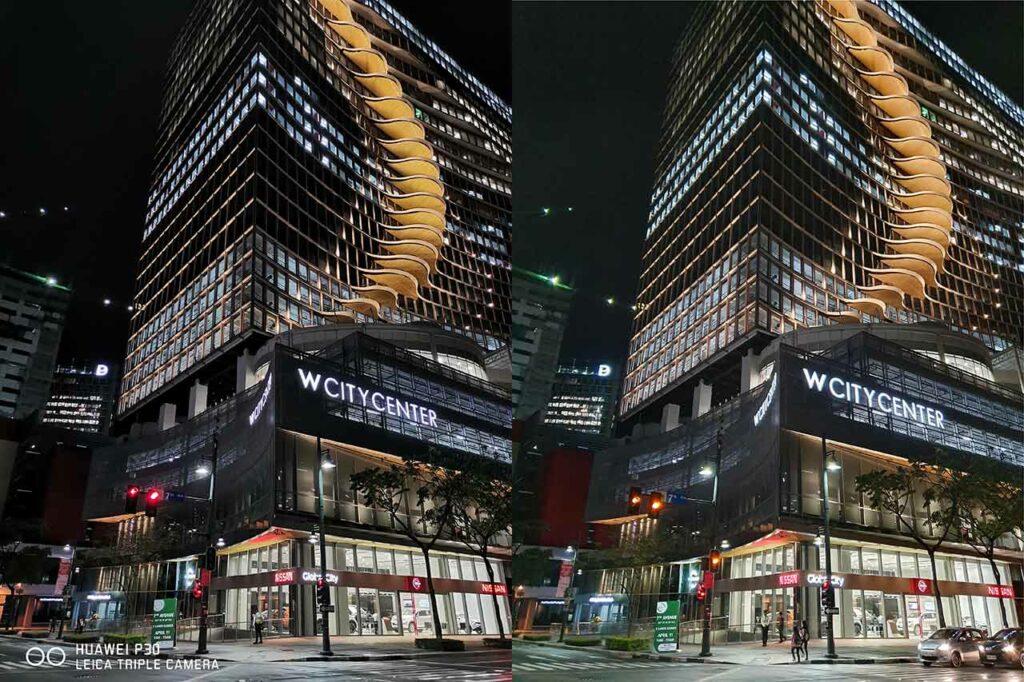
Huawei P30 vs Samsung Galaxy S10: Auto mode
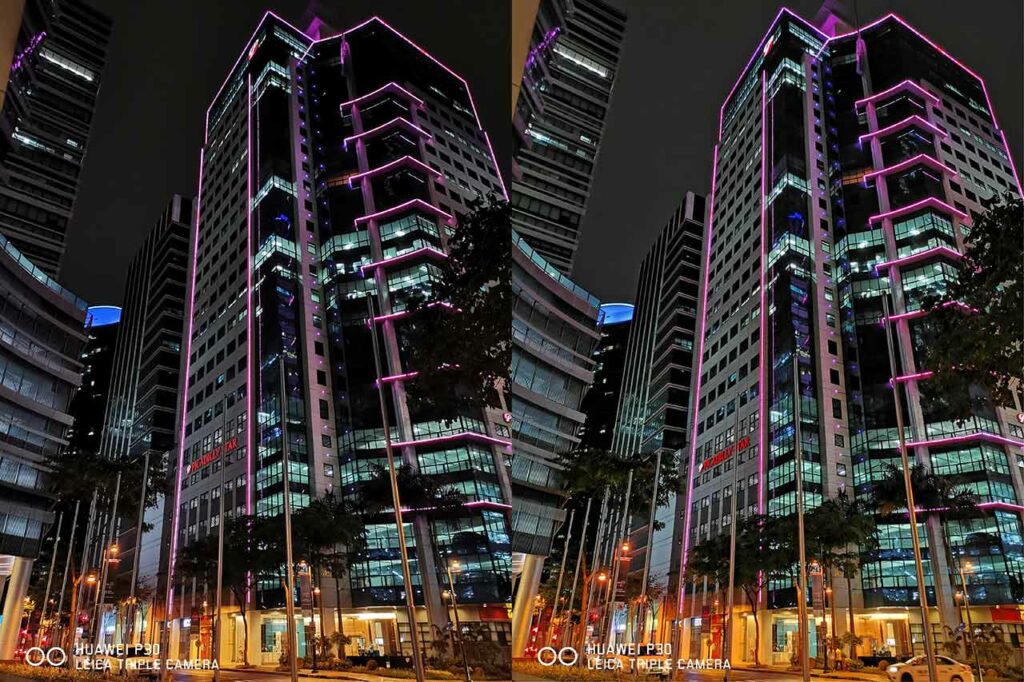
Huawei P30: Auto mode vs Night mode. Too bad the latter feature hasn’t been rolled out to our Samsung Galaxy S10 unit just yet
Plus, the P30 can do 30x zoom compared to 10x zoom on the Galaxy S10. At maximum magnification, the difference between the two zoom cameras is staggering. Using the 30x zoom facility, we can see details that are indistinguishable in the 1x setting.

Ultra-wide, 1x, 5x zoom, 10x zoom, and 30x zoom shots taken with the Huawei P30 at night
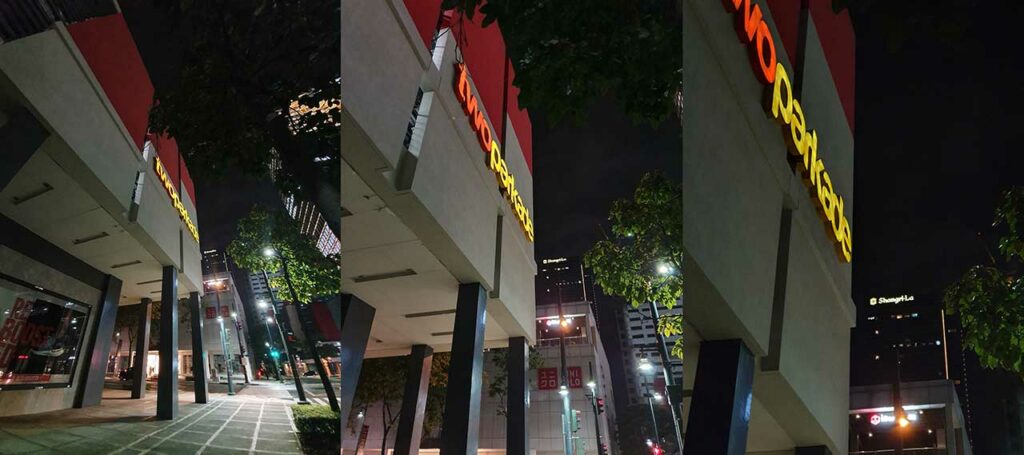
Ultra-wide, 1x, and 10x zoom pictures captured on the Samsung Galaxy S10
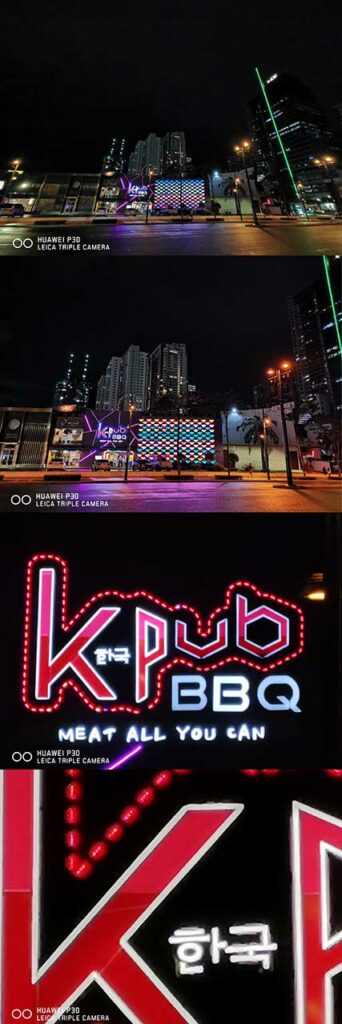
Huawei P30: Ultra-wide, 1x, 10x zoom, and 30x zoom pictures this time
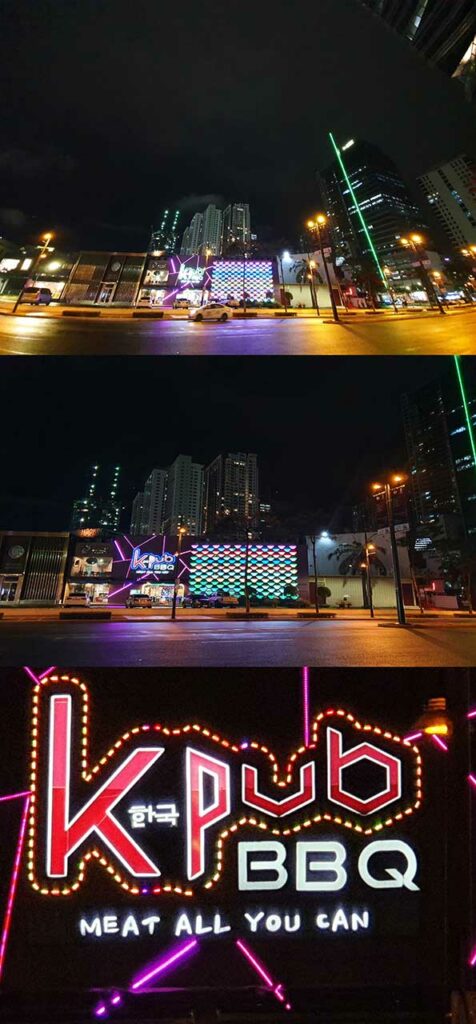
Samsung Galaxy S10: Ultra-wide, 1x zoom, and 10x zoom shots
The front-facing camera of the Samsung flagship features a 10-megapixel sensor. It comes with a suite of effects that you can use to create portrait-style headshots. But surprisingly for us, the Huawei trumps the Galaxy, something we didn’t see coming.
Daytime selfies taken in Auto mode
Daytime selfies taken in Portrait mode (with bokeh effect)
Selfies shot in Auto mode at night
Selfies shot in Portrait mode (with bokeh effect) at night
We were genuinely impressed by the pictures taken with the P30. If it wasn’t for the higher-specced and more expensive P30 Pro, we would argue that it currently boasts the best set of cameras on a phone.
Performance
Of course, as expected of a modern flagship, the Huawei P30 and Samsung Galaxy S10 are powered by two of the fastest processors ever used in a smartphone. The P30 has a Kirin 980 chip, whereas the S10 is backed by an Exynos 9820. It’s worth mentioning that Huawei’s chipset is fabricated using a 7nm process compared to an 8nm process used for the Exynos chip. A lower nanometer number indicates that the chip platform is based on a smaller node, so it should lead to faster performance and better efficiency.
The Huawei P30 has a Kirin 980 chip fabricated using a 7nm process, whereas the Samsung Galaxy S10 is backed by an 8nm Exynos 9820
Both handsets have 8GB RAM and 128GB of native storage that owners are free to expand upon with the use of a memory card. So it goes without saying that they are incredibly fast and responsive, and the storage should be sufficient for most people.
Day-to-day usage is a pleasure. We haven’t noticed any significant app slowdown, even while running multiple applications and a web browser at the same time. We’ve also had zero issues playing the most demanding games at the highest graphics preset available. There is a high-frame-rate option on titles that support it, such as Mobile Legends: Bang Bang and PUBG Mobile.
The Samsung Galaxy S10 posted higher benchmarks than the Huawei P30, although that doesn’t necessarily translate into a smoother experience, especially in the games that we tried.
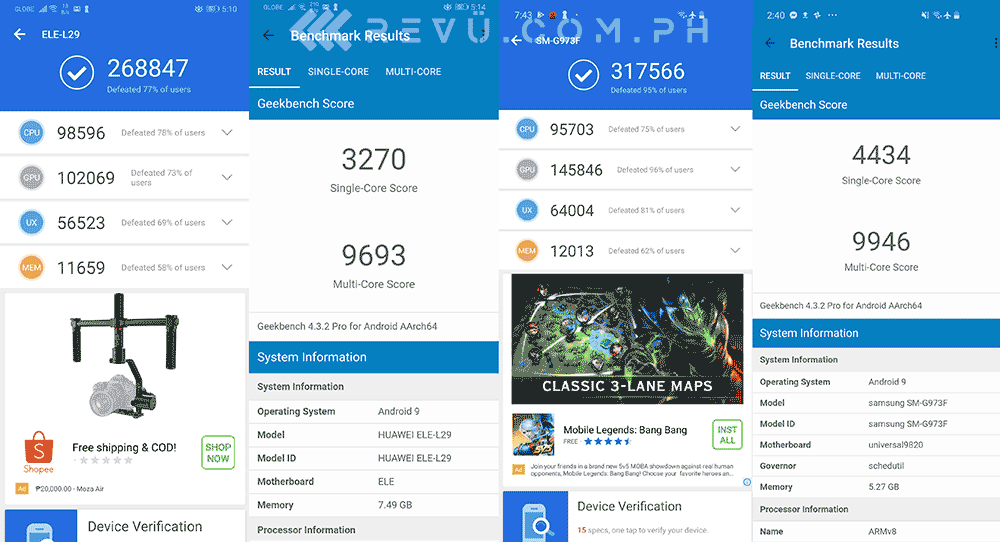
The Samsung Galaxy S10 (right) posted higher benchmarks than the Huawei P30, but that doesn’t necessarily translate into a smoother experience, especially in the games that we tried
Battery life
The Huawei P30 packs a pretty sizable 3,650mAh battery, which was enough to get us through a full day of moderate to heavy usage with a decent amount of juice left in reserve. It should last most users a day and a half without worrying about cutting back on heavier tasks and doing other things to conserve power.
Gaming and taking a ton of pictures — which you’ll want to do on the P30 — will drain the battery faster than most other activities. But that’s normal, and the impact on battery life won’t affect your mileage too much.
READ ALSO: Huawei Philippines to replace your old device’s battery for only P799 ($15)
Meanwhile, the Samsung Galaxy S10 uses a smaller 3,400mAh battery pack compared to the P30’s. Battery life, while respectable, isn’t uniquely impressive, or better than our daily average usage time with the Huawei. Sure, it can last a day of normal use. Anything beyond that and you’ll have to lower the resolution and brightness, turn off Always On Display, or configure other options in the settings to stretch the battery life further.
The S10’s battery life, while respectable, isn’t better than our daily average usage time with the P30
The P30 supports fast charging up to 22.5 watts over a USB-C connection. The Samsung phone, on the other hand, charges slower at 15 watts, leading to longer top-up times. The power brick included in the box of the P30 was able to charge our unit from empty to full capacity in about an hour. Impressive.
The P30 doesn’t have wireless charging and wireless reverse charging, something the S10 offers. These are not particularly huge omissions for a flagship, but they certainly would have been nice to have.
Final thoughts
Just when you thought Samsung is back at the top of the high-end segment, here comes the Huawei P30 with a nice OLED display, a new image sensor bearing a different pixel arrangement to conventional sensors, and battery life for days. The 30x zoom is a nice feature on top of what the main and ultra-wide cameras can do, while the Kirin 980 paired with 8GB RAM provides the kind of performance you may be looking for in a flagship handset.
The P30 also costs much less than the Galaxy S10, which is priced in the same range as the P30 Pro. And though the S10 has its bright spots, the Huawei phone offers better bang for the buck without making compromises where it matters. You’ll also benefit from superior camera performance overall. In its latest offering, Huawei has delivered something that gives you almost anything you could ask for in a premium phone.
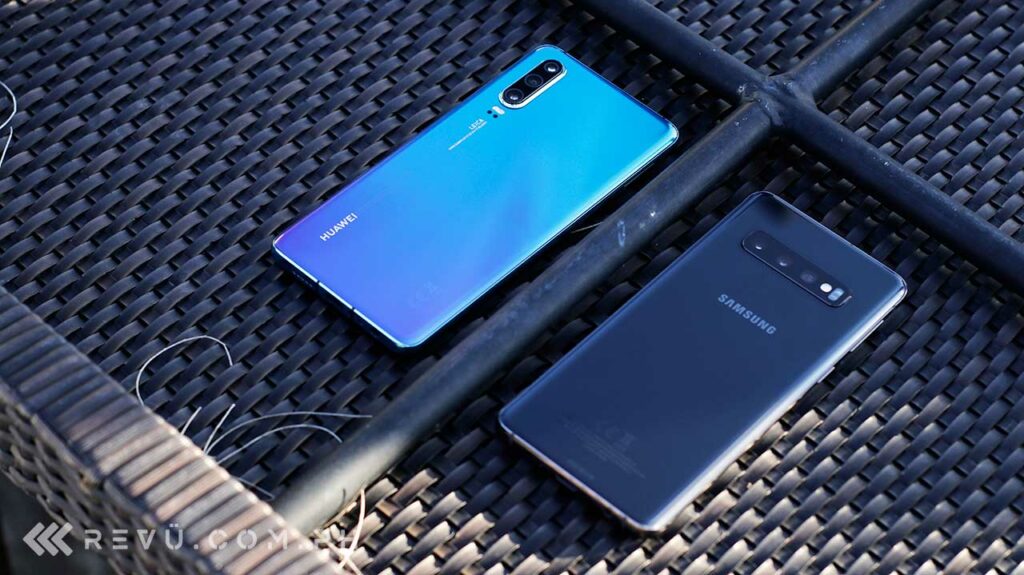
Although the Samsung Galaxy S10 has its bright spots, for us, the Huawei P30 offers better bang for the buck without making compromises where it matters
Huawei P30 vs Samsung Galaxy S10: Specs comparison

So which one is for you?
Share this Post


